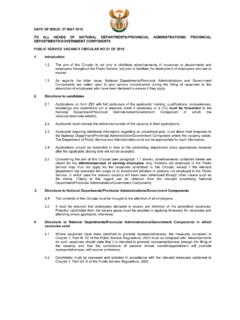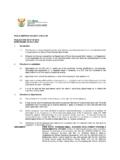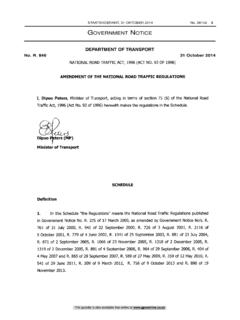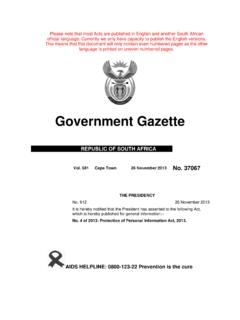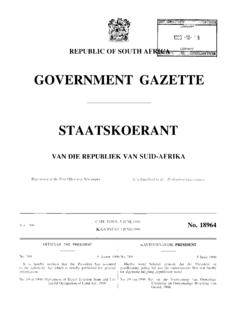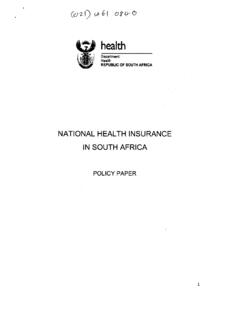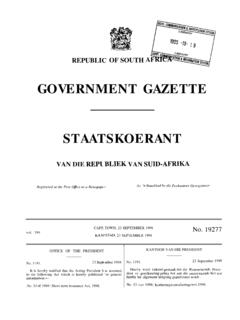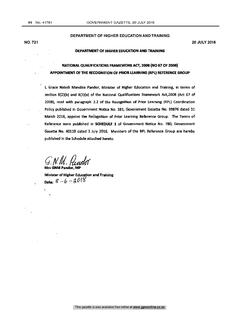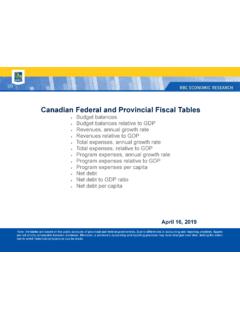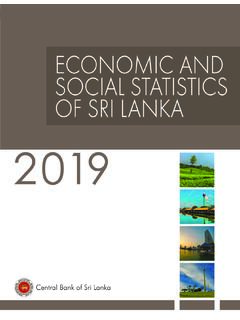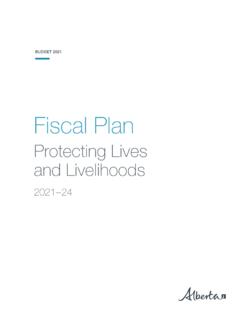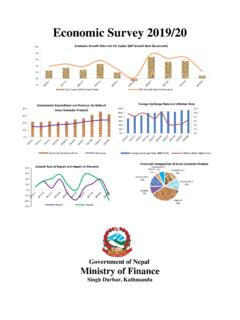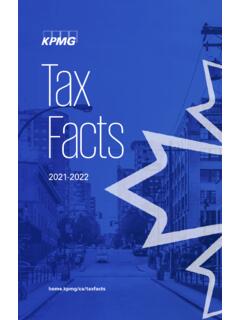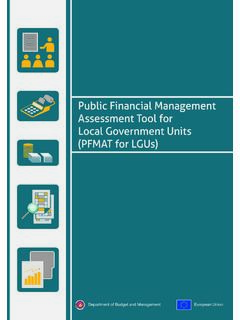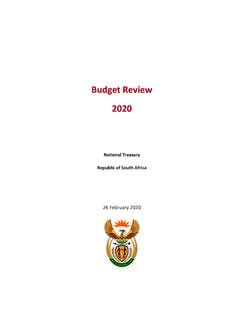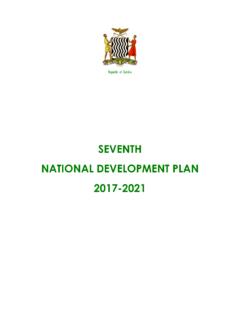Transcription of The Integrated Sustainable Rural Development Strategy - …
1 THE Integrated Sustainable Rural Development Strategy (ISRDS) 17 November 2000 iTABLE OF CONTENTS Foreword Preface Acknowledgements table of Contents i List of Tables iii List of Figures iii List of Annexures iii List of Abbreviations iii Executive Summary iv Introduction Section 1: The International Evolution of Approached to Rural Development 2 a) Characteristics of Rural areas b) Evolution of approaches to Rural Development c) Decentralisation d) Lessons of project design Section 2: Rural South Africa 6 a) Rural areas and Rural people b) HIV/AIDS and the Rural poor c) Strategic pointers Section 3: Implementation and Design of Rural South Africa since 1994 12 a) The legal and policy framework for Rural Development b) Achievement of Rural Development form 1994 2000 c) Lessons of the early period d) Towards an Integrated Rural Development Strategy Section 4: Key Elements and Vision 19 a) Rural Development b) Sustainability c) Integration ii d) Dynamics of growth in Rural areas e) Rural safety net as an Integrated part of the Integrated Sustainable Rural Development Strategy .
2 Section 5: The Approach: How Will it Work? 24 a) The basket of selected services b) Initial focus on selected areas c) Participation and selection of desired services d) The role of information e) Financing the basket of selected services f) Advantages and risks of a geographic focus on nodes g) Performance contracts to bind commitment h) Continued viability of the mechanism as the budgetary process evolves i ) Monitoring performance indicators Section 6: Complementary Measures to Support the Strategy 32 a) Human resource Development and capacity building b) Land reform: implement the revised programme c) Community based income generation projects d) Social assistance and safety nets e) Rural Development finance Section 7: Institutional Framework for Coordination of the Strategy 36 a) The political sphere b) The operational sphere c) Stakeholder mobilisation Section 8: Phasing for Implementation of The Integrated Strategic Rural Development Strategy 41 iii LIST OF TABLES table 1: Rural communities socio-economic characteristics table 2: Actions associated with the phased implementation of the ISRDS LIST OF DIAGRAMS Diagram 1: ISRDS Strategic Framework Diagram 2.
3 The amalgamated expenditure envelope Diagram 3: Institutional arrangements for the co-ordination of the IRSDS Diagram A1: Alternative assignments of responsibilities for implementation of the matching grant programme LIST OF ANNEXURES Annexure 1: Tables of poverty rates by province, district council and magisterial district Annexure 2: Integrated Development planning Annexure 3: How will the community based income generation programme work? LIST OF ABBREVIATIONS ABET Adult Basic Education Programme CBO Community Based Organisation CBPWP Community Based Public Works Programme CMIP Consolidated Municipal Infrastructure Programme GDP Growth Domestic Product GEAR Growth, Employment and Redistribution Programme IDP Integrated Development Plan IDT Independent Development Trust IRDPS Integrated Rural Development Projects ISRDS Integrated Strategic Rural Development Strategy IT Information Technology LED Local Economic Development NGO Non-Government Organisation RDP Reconstruction and Redevelopment Programme SDI Spatial Development Initiative SMME Small Medium and Micro Enterprise UN United Nations ivThe Integrated Sustainable Rural Development Strategy (ISRDS)
4 Executive Summary The South African Government, in consultation with a wide range of key stakeholders, is now launching a new stage of concerted effort to improve opportunities and well-being for the Rural poor. In taking this step, the Government is building on six years of experience with its own Rural programmes, as well as assimilating key lessons from similar efforts worldwide. The resulting Integrated and Sustainable Rural Development Strategy is idealistic in its vision and practical in its focus on mechanisms of implementation. The Integrated and Sustainable Rural Development Strategy (ISRDS) is designed to realize a vision that will attain socially cohesive an stable Rural communities with viable institutions, Sustainable economies and universal access to social amenities, able to attract and retain skilled and knowledgable people, who equipped to contribute to growth and Development .
5 The approach outlined in the Strategy is applicable and viable for the entire country, and looks toward a horizon of 2010. It will be implemented initially in selected areas of concentration, or pilot areas, and subsequently expanded. The Strategy in its totality presents an opportunity for South Africa s Rural people to realize their own potential and contribute more fully to their country s future. The implementation of the ISRDS will use and develop existing institutional, planning, management and funding mechanisms to focus the expenditure of government in the three spheres to more effectively and efficiently respond to needs and opportunities.
6 It is not predicated on additional funding from government. It will increase the efficiency of the application of public funds in Rural areas to create appropriate outputs in the places where they are most needed. The structures and procedures of the Medium Term Expenditure Framework will provide the mechanism for realizing national and provincial budget structures to meet ISRDS objectives. Additional funding will be the derived from the structure of delivery relationships that will be established. Sources will include the private sector, public-private partnerships, organs of state and the donor community.
7 South Africa is in an ideal position to take on board one of the key lessons of the international experience; namely, that successful Rural Development must be implemented in a participatory and decentralised fashion in order to respond to articulated priorities and observed opportunities at the local level. The reform of municipal government places organs of local government in a central role in integrating programmes to achieve synergistic Rural Development . Many will need assistance and guidance to develop capacity, but their role and responsibilities are clearly established. They are required to clearly identify local Development needs and opportunities and to plan to respond to these.
8 They must align their budgets to achieve their planned objectives. They satisfy the core lessons of international experience as decentralised and accountable entities managing participatory planning and implementation processes. They will be supported by provincial governments which will co-ordinate, integrate and align planning outputs. provincial governments will also be key agents in the co-ordination and alignment of Development inputs from public and other sources. At the same time, the Presidency will provide strong strategic leadership and coordination. Each of the line departments will make a critical contribution, and their efforts to achieve synergy and higher effectiveness in their own programmes will be assisted by the strengthened integrative mechanism at the local (municipal) provincial and national spheres.
9 V Section 1 outlines evaluation of international approaches to Rural Development , which have hinged around inadequate local capacity and tendencies to excessive centralization of decision making. Efforts to achieve cross-sectoral delivery through Integrated Rural Development projects in the 1970 s tended to fail on inadequate proper local participation and inadequate building of local capacity. As a result, programme design retreated to single-sector approaches. Recent experiences in programme design suggest that decentralization accompanied by promotion of greater local power and autonomy in decision-making can offer opportunities to improve outcomes.
10 The evidence indicates that a number of characteristics pertain: fiscal transfers must provide incentives for local government and be transparent, predictable and autonomous; an appropriate legal framework must define relationships between different levels of government, and must provide a clear role for non-government institutions; institutional capacity to meet the responsibilities and obligations of decentralized authorities must be created and nurtured; a clearly defined system of incentives and penalties is required to contribute to more efficient investment decision-making and to discourage misuse of funds. Recent experiences in project design suggest that urban- Rural bias and improved achievement of intended outcomes are achieved where certain key characteristics pertain: targeting mechanism should be simple, explicit and memorable, based on objective criteria to minimize political interference in resource allocation; participation in financing of projects and sub-projects generates a sense of ownership and aligns investments to be true, perceived needs generate costs savings and increases local accountability; careful design of information campaigns is essential and technical assistance and training should be accessible.
